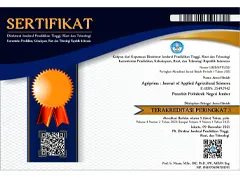Investigation of In Vitro Apocarotenoid Expression in Perianth of Saffron (Crocus sativus L.) Under Different Soil EC
DOI:
10.25047/agriprima.v7i1.508Downloads
Abstract
Crocus sativus is a triploid sterile plant with red stigmas belonging to family of Iridaceae, and sub family Crocoideae. Crocin, picrocrocin, and safranal are three major carotenoid derivatives that are responsible for color, taste and specific aroma of Crocus. Saffron flowers are harvested manually and used as spice, dye or medicinal applications. The natural propagation rate of most geophytes including saffron is relatively low. An in vitro multiplication technique like micropropagation has been used for the propagation of saffron. To understand the efficiency of this alternative and study the molecular basis of apocarotenoid biosynthesis/accumulation, the RT-PCR method was performed on perianth explants that were cultured on MS medium to observe the level of expression of zeaxanthin cleavage dioxygenase (CsZCD) gene during stigma development, and also the impact of soil EC on its expression. The present study was conducted at Plant molecular and physiology Lab, Alzahra University, Tehran, Iran during 2011-2013. Stigma-like structures (SLSs) on calli were collected from immature perianth explants from floral buds of corms that were collected from Ghaen city, and compared to (Torbat-e Haidariye, Mardabad and Shahroud cities) for investigating the impact of different soil EC on CsZCD expression. The results indicated that CsZCD gene was highly expressed in fully developed red SLSs in perianth of cultured samples of Shahroud with the highest salinity. In this research, a close relationship between soil EC and second metabolites regulation is studied. Overall, these results will pave the way for understanding the molecular basis of apocarotenoid biosynthesis and other aspects of stigma development in C. sativus.
Keywords:
Crocus sativus, micropropagation, gene expression, salinity stressReferences
Arigoni, D., Sagner, S., Latzel, C., Eisenreich, W., Bacher, A., & Zenk, M. H. (1997). Terpenoid biosynthesis from 1-deoxy- d -xylulose in higher plants by intramolecular skeletal rearrangement. Proceedings of the National Academy of Sciences, 94(20), 10600–10605. https://doi.org/10.1073/pnas.94.20.10600
Ascough, G. D., Erwin, J. E., & van Staden, J. (2009). Micropropagation of iridaceae—a review. Plant Cell, Tissue and Organ Culture (PCTOC), 97(1), 1–19. https://doi.org/10.1007/s11240-009-9499-9
Bouvier, F., Suire, C., Mutterer, J., & Camara, B. (2003). Oxidative Remodeling of Chromoplast Carotenoids. The Plant Cell, 15(1), 47–62. https://doi.org/10.1105/tpc.006536
Bremner, J. M. (2018). Nitrogen-Total (pp. 1085–1121). https://doi.org/10.2136/sssabookser5.3.c37
Britton, G., Pfander, H., & Liaaen-Jensen, S. (1998). Carotenoids, Volume 3: Biosynthesis and Metabolism. Birkhäuser Basel.
Castillo, R., Fernández, J.-A., & Gómez-Gómez, L. (2005). Implications of Carotenoid Biosynthetic Genes in Apocarotenoid Formation during the Stigma Development of Crocus sativus and Its Closer Relatives. Plant Physiology, 139(2), 674–689. https://doi.org/10.1104/pp.105.067827
Cazzonelli, C. I. (2011). Carotenoids in nature: insights from plants and beyond. Functional Plant Biology, 38(11), 833. https://doi.org/10.1071/FP11192
Deo, B. (2003). Growing Saffron—The World’s Most Expensive Spice, Crop & Food Research. In Crop And Food Research.
Himeno, H., & Sano, K. (1987). Synthesis of Crocin, Picrocrocin and Safranal by Saffron Stigma-like Structures Proliferated in Vitro. Agricultural and Biological Chemistry, 51(9), 2395–2400. https://doi.org/10.1080/00021369.1987.10868396
Mashayekhi, S., & Hosseinzadeh Namin, M. (2015). Effects of soil conductivity on properties of saffron corms and in vitro production of its style explants. Progress in Biological Sciences, 5(2), 273–286.
Mir, J. I., Ahmed, N., Wafai, A. H., & Qadri, R. A. (2012a). Variability in stigma length and apocarotenoid content in Crocus sativus L . selections of Kashmir. 21(2), 169–173.
Mir, J. I., Ahmed, N., Wafai, A. H., & Qadri, R. A. (2012b). Relative expression of CsZCD gene and apocarotenoid biosynthesis during stigma development in Crocus sativus L. Physiology and Molecular Biology of Plants, 18(4), 371–375. https://doi.org/10.1007/s12298-012-0131-9
Mirbakhsh, M., & Hosseinzadeh, N. M. (2013). Investigation of in vitro apocarotinoid gene expression in perianth of saffron (Crocus sativus). 2nd National Congress on Medicinal Plants.
Mirbakhsh, M., & Sohrabi, S. S. (2022). Effect of short and long period of salinity stress on physiological responses and biochemical markers of Aloe vera L. Ilmu Pertanian (Agricultural Science), 7(3), 178. https://doi.org/10.22146/ipas.78646
Moraga, A. R., Nohales, P. F., Perez, J. A. F., & Gômez-Gômez, L. (2004). Glucosylation of the saffron apocarotenoid crocetin by a glucosyltransferase isolated from Crocus sativus stigmas. Planta, 219(6), 955–966. https://doi.org/10.1007/s00425-004-1299-1
Moraga, A. R., Rambla, J. L., Ahrazem, O., Granell, A., & Gómez-Gómez, L. (2009). Metabolite and target transcript analyses during Crocus sativus stigma development. Phytochemistry, 70(8), 1009–1016. https://doi.org/10.1016/j.phytochem.2009.04.022
Murashige, T., & Skoog, F. (1962). A Revised Medium for Rapid Growth and Bio Assays with Tobacco Tissue Cultures. Physiologia Plantarum, 15(3), 473–497. https://doi.org/10.1111/j.1399-3054.1962.tb08052.x
Naik, P., Chanemougasoundharam, A., Paul Khrana, S., & Kalloo, G. (2003). Genetic manipulation of carotenoid pathway in higher plants. Current Science, 85(10), 1423–1430.
Namin, M., Ebrahimzadeh, H., Ghareyazie, B., Radjabian, T., & Namin, H. (2010). Initiation and Origin of Stigma-Like Structures (SLS) on Ovary and Style Explants of Saffron in Tissue Culture. Acta Biologica Cracoviensia Series Botanica, 52(1). https://doi.org/10.2478/v10182-010-0007-7
Page, A. L., Miller, R. H., & Keeney, D. R. (1983). Methods of Soil Analysis: Part 2 Chemical and Microbiological Properties. American Society of Agronomy Inc.
Pfander, H., & Schurtenberger, H. (1982). Biosynthesis of C20-carotenoids in Crocus sativus. Phytochemistry, 21(5), 1039–1042. https://doi.org/10.1016/S0031-9422(00)82412-7
Rohmer, M., Knani, M., Simonin, P., Sutter, B., & Sahm, H. (1993). Isoprenoid biosynthesis in bacteria: a novel pathway for the early steps leading to isopentenyl diphosphate. Biochemical Journal, 295(2), 517–524. https://doi.org/10.1042/bj2950517
Siregar, B. (2017). Analisa kadar C-Organik dan perbandingan C/N tanah di lahan tambak Kelurahan Sicanang Kecamatan Medan Belawan. Warta Dharmawangsa, 53.
Tuan, P. A., Kim, J. K., Lee, S., Chae, S. C., & Park, S. U. (2013). Molecular Characterization of Carotenoid Cleavage Dioxygenases and the Effect of Gibberellin, Abscisic Acid, and Sodium Chloride on the Expression of Genes Involved in the Carotenoid Biosynthetic Pathway and Carotenoid Accumulation in the Callus of Scutel. Journal of Agricultural and Food Chemistry, 61(23), 5565–5572. https://doi.org/10.1021/jf401401w
Tuteja, N. (2007). Abscisic Acid and Abiotic Stress Signaling. Plant Signaling & Behavior, 2(3), 135–138. https://doi.org/10.4161/psb.2.3.4156
USDA. (2014). Soil Survey Field and Laboratory Methods Manual.
Waśkiewicz, A., Muzolf-Panek, M., & Goliński, P. (2013). Phenolic Content Changes in Plants Under Salt Stress. In Ecophysiology and Responses of Plants under Salt Stress (pp. 283–314). Springer New York. https://doi.org/10.1007/978-1-4614-4747-4_11
License
Copyright (c) 2023 Mandana Mirbakhsh, Zahra Zahed, Sepideh Mashayekhi, Monire Jafari (Author)

This work is licensed under a Creative Commons Attribution-ShareAlike 4.0 International License.
You are free to:
- Share — copy and redistribute the material in any medium or format.
- Adapt — remix, transform, and build upon the material for any purpose, even commercially.
Under the following terms:
- Attribution — You must give appropriate credit, provide a link to the license, and indicate if changes were made. You may do so in any reasonable manner, but not in any way that suggests the licensor endorses you or your use.
- ShareAlike — If you remix, transform, or build upon the material, you must distribute your contributions under the same license as the original.
- No additional restrictions — You may not apply legal terms or technological measures that legally restrict others from doing anything the license permits.









